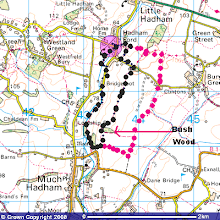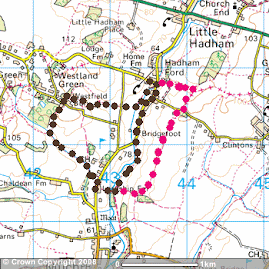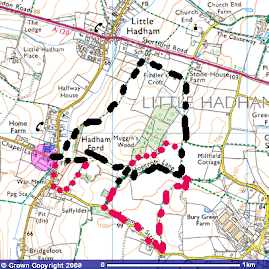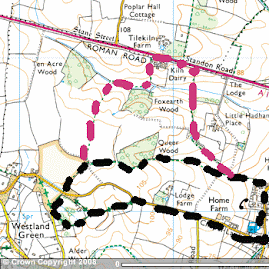This part will highlight areas slightly further afield from the town, south along the River Stort
River Stort South: Twyford Locks to Spellbrook Locks.
This bird walk begins and ends at Twyford Locks in Pig Lane, off the main Sawbridgeworth/Stortford Raod near The Boys' High School. Parking is available just before the river opposite the flats on the river bank.
Head south along the towpath. Cormorants can often be seen, both fishing in the river or resting at the top of two favoured trees. One of these is on the opposite bank, a tall dead tree, whilst the other is in the groumnds of Wallbury, just 50 yards before Spellbrook Locks. A good stretch of river for Kingfisher. Mallards and Moorhens all along this part and towards Spellbrook there are usually 6 - 8 Little grebe that overwinter on the river. In the alder trees near where the power lines cross the river Siskin and Redpoll are frequent sights. These can also be found in the trees on the far bank near the two small footbridges on the tow path.
A thin metal bridge footbridge crosses the river after a few hundred metres from Twyford. Known as Roly Croak as from Victorian days it is worth using to access the open fields between the river and railway line. Both Great spotted woodpecker and green woodpecker are both resident here and a good sight for winter thrushes: Mistle thrush, Fieldfare and Redwing.
Bullfinches reside in the dense bramble bush by the bridge whilst overhead Kestrels are common. Back on the towpath by the two small footbridges it is worth checking the adjacent field for gulls and occasional parties of Lapwing. Take time to scan the whole area from the Red brick bridge that takes the walker on to Thorley Wash Reserve (mentioned later.)
From this bridge to the lockgates there is good birding to be had in the swampy area on the left. Here, Great tits, Blue tits, Long tailed tits, Robins and Wrens a plenty along with possible Coal tit and the rarer Marsh Tit. Another bird here is more likely to be heard than seen. A sudden explosion of loud song will indicate a Cetti's warbler is present. A secretive bird that keeps low and in heavy vegetation. Overhead, Common buzzards, Rooks, Crows and Jackdaws whilst actually in the swamp are several large oaks. These have in the past held a Lesser spotted woodpecker. Look for it walking along top boughs. often clinging on to the underside of these. A grey wagtail often frequent the area around the Lockgates.
 |
| Grey wagtail |
Spellbrook Locks to Tednambury Locks:
Car can either be parked before or after the lockgates, or possibly in the Three Horseshoes car park. Pick up the tow path heading south and check the cut opposite that flows near the house. Moorhen, Coot and Mallards here, whilst in the trees the expected tits, Robins and Wrens. At the first meander it is worth checking the opposite field, often holding cattle for crows etc as well as Wood pigeons and Magpies. As always, Red kites and Common buzzards soaring overhead. This is a field that one of the local Barn owl uses for hunting and as the nights get longer it can be possible to see the bird up to half an hour before dusk as well as at first light.
The field on the left is owned by Herts and Middlesex Wildlife Trust and can get quite marshy. Very difficult to find but often good numbers of Snipe here and in the hawthorn scrub, plenty of Reed bunting. They use this area for winter roosting and in previous years up to 30 have been recorded coming in an hour or so before dusk A little further along there is the bridge over the cut into the marina. Use this height to scan the standing water in the far field of the HMWT site. Winter duck species such as Teal and Wigeon have been known to stop off here and usually Little egret and Grey heron can be observed fishing or just standing around. Long tailed tits on the opposite bank along with Chaffinches, Linnets and Goldfinches.
The walker can either continue along the towpath that enters wide open areas of fields to spot more of the same or return and head to Thorley Wash Reserve.
 |
| Reed bunting male |
Thorley Wash:
Several ways to getting on to this HMWT Reserve. Either by crossing the Red brick bridge some 400 yards from Spellbrook locks or by parking near Challenge gym just after the bypass roundabout on the road to Sawbridgeworth. Once parked here, track back 100 yards and there is a public footpath that crosses a field opposite Thorley Wash House and then over the railway line. Over the stile and on to a wooden bridge into the reserve. A circular path begins here, on the left. Check the river for grey wagtail before scanning the reserve for Reed bunting, often seen on top of the bushes. Linnets and Goldfinches frequent here, flying in numbers, their dipping flight a good indication of finch flight.
Great spotted woodpeckers in the large willows on the left by the wooden carvings that include an otter, dragonfly and owl. This is another site where the resident Barn owl can be found before dusk and at first light. Worth a visit on its own if wrapped up warm on a well lit evening.
Around a bend in the path and there is a copse of willow over the fence. Often water remains here and it therefore attracts Mallards, Moorhens and possibly a wader such as snipe. Tit species frequent the trees here. Kestrels are a common sight, often on the telegraph poles or overhead wires.
The path wends around to the Stort Navigation where Little grebe can be seen. They will often dive just as you spot them and never appear again. They will have swum underwater to the reeds in the bank to hide. Crouch down and soon they will reappear for good views. The path takes the walker back to the Red brick bridge. Turn right back in to the reserve. In this dark area tree creepers can be found whilst on the other side of the river the alder trees may hold large flocks of Siskins, the adult male a splendid yellow and black bird, smaller than a chaffinch but the 1st year birds and females are much browner, showing slight hints of yellow in their streaked plumage. Check through these flocks as often there will be a greyer and lighter coloured bird with a red forehead, a Lesser redpoll. Listen out here for a sound likened to a squealing pig. This will be the call of the often present Water rail, a small brown bird with a bright red bill, a member of the same family as moorhens and coots. They rarely come out into the open apart from when it is very icy. Back in to the reserve and scan to the left where there has been a resident Fallow deer for a couple of years now before you arrive back at the footbridge by the railway line.
 |
| Water rail |
Southern Country Park:
Either park in St Michael's Mead near the lake or use the car park found along Thorley Lane. The lake will be the main attraction here, with the reedbeds and open water. Wintering gulls can reach good numbers with most being Black headed gulls with their bright red beaks and legs, showing through winter a black spot on their head. Worth checking for other species of gull where the larger grey on will be Herring, any with darker wings and back will most likely be Lesser black backed gulls but also a Common gull may well be present: yellow bill, greeny/yellow legs and a much cleaner looking bird than the herrings.
On the water, Mallards, Coots and Moorhens and always the chance find of other duck species. In the reedbeds by the boardwalk a good opportunity to see Reed bunting and, most likely, only hear Cetti's warbler and Water rail. Possibility of overwintering chiffchaff here, too, flitting through the young willows. On the far side of the lake and on the grassy areas, Magpies and Wood pigeons as well as flocks of Fieldfare and Redwing. In the trees, Wrens, Robins and tit species as well as Nuthatches and Tree creepers. Great spotted woodpeckers can be seen flying from tree to tree and always a chance of a Green woodpecker feeding on the ground, invariably looking for ants and buried acorns. Where there are berry trees, which grow in profusion here, wait a while for overwintering Blackcaps as well as more regular species. A good chance of Waxwings here if they arrive here this winter. Also, winter thrushes will be feeding upon the berries of hawthorn and Whitebeam as well as finishing off the windfall apples. A good wander around here will certainly give a good selection of the winter bird species present and will be especially good on a crisp, cold and frosty morning or if we get a good overnight fall of snow.
 |
| Common gull, note leg and beak colour as well as the well rounded head. |
 |
| Black headed gull in winter plumage |
 |
| Herring gull |
 |
| Spot the Common gull in this group. Photo from a long walk in Poland some years ago, this being a foggy morning with -8C temperatures |












































No comments:
Post a Comment